
Wine Culture and Information since 2002 - Volume 22
 Wine Culture and Information since 2002 - Volume 22 |
|
Issue 46, November 2006 |
Contents |
|
|
The Power of Suggestion |
|
Wine is a pretty common subject, now considered as a fashionable and trendy subject, every communication media dedicates some time to the beverage of Bacchus. Television, newspapers, radio, internet and magazines all dedicate columns and programs to the visibility of wine. There is no doubt wine is indissolubly connected to our culture, a reason which probably justifies its imposing presence on mass communication. Talking about wine, there is no doubt about this, is good for wine, provided it is done honestly, correctly and with good criteria, in every aspect and loyally. What it is not good for wine are some “know-it-all” behaviors which inevitably get full of exaggeration, making wine into something it is not, as if they would made everyone believe at any cost iron is like gold. There is no doubt that being in the limelight, in front of an audience more or less interested and more or less disposed to listen critically to some non sense, offers a good temptation to mount a silly show, even convinced to appear credible, authoritative and indisputable. Anyway wine - besides being a beverage, first of all - it essentially is an emotion, a subjective experience in which everyone finds something different from any other else. We are not all alike. There is who is disposed to listen and to support the sumptuous comments of others, who with a “know-it-all” and expert behavior also believing they can convince everyone with their infallible opinion. Most of the times, being in the doubt of ignorance and discomfort, it is always better to stay in the wave of majority, in order to have the impression of being on the right side. According to a social point of view, belonging to a group which is identifiable in specific philosophies, school of thought and life styles, it is something very interesting for human beings, as if this would be enough in order to have an identity and dignity, in other words, to be acceptable. Something that, there is no doubt, we can find in wine as well, which is sometimes used as an element of identity among its supporters. How much important is the power of suggestion in the communication of wine? Suggestion in wine plays an important role, just like in every other product, just like in every other type of marketing. An example can be represented by the so called labels drinkers who consider, first of all, the producer and what it is written on the label, then to the content of the bottle. Even worse are the ones who are fond of some labels and some wines without having never tasted them, without having never seen their bottles for real. Power of suggestion! It is enough to be convincing in saying a producer or a wine are of high quality, of impeccable elegance and prestige, and it is enough to spread a common and strong idea without even providing or having any objective proof of facts. Convictions which then flood everywhere and create other suggestions: an infallible way to create a myth. A spreading of the word which gets bigger and bigger at every passage and becomes almost unreal, an illusion so far from reality which manifests all of its normality when, finally, one has the opportunity to personally try it. Something which happens, of course, to few lucky ones only. Indeed this exaggerated suggestion can also create a negative effect on those subjects who, having a sense of criticism, finally have the chance to taste the wine of their dreams and, excited because of their fantastic expectations, after having tasted it, they are disappointed and all they can say is «well, is it all that only?». Disappointment is even bigger when they find out there are many wines sold at very lower prices and have nothing less than the most prestigious wines. Moreover, if we base our criticism on price, if we are disposed to forgive some faults to a 10 euros wine, to a 100 euros wine we should not forgive anything, not even the slightest fault. After all, if a producer asks much for his or her wines, he or she must be disposed to give much as well: it is not acceptable that with the only suggestion of price they can believe consumers are happy for a presumed quality ensured by the words, or better to say, by the price. A higher price does not always mean a better quality. Moreover, to what deleterious consequences bring the suggestions caused by some “experts”, who feel so authoritative because they are on the pulpit of the television, they believe they can say the most idiot non sense also convinced they are credible. Of course, we have no intention in complaining about television shows talking about wine, we do not want to associate the bad things to the good ones. However, it should be right in case someone would make sure about the reliability and the competence of some “personages” who as soon as they are on the TV, the best they can do is to open the mouth and let the air out. To give a better idea of what we are talking about, we can cite a couple of things seen on a two different TV shows. The first one is about a cook who, after having finished the preparation of his risotto with shrimps and zucchini, when the host of the show asked him about the wine to be matched to his dish, the impeccable cook, without hesitation - as well as without thinking about what he was saying - triumphantly suggested an Amarone della Valpolicella! De gustibus non disputamdum est, (there is no dispute about tastes) however in this specific case, saying it is an exaggeration is really too little. It is like facing an army of ants with a flamethrower! What can we say about that competent wine expert - this is how the anchorwoman introduced him - who in another TV show said there is no difference between Bordeaux and Barolo? Not bad, very good job! After all, they both are wines, there is no doubt about this! Who knows whether the impeccable expert has ever tasted these two wines, or better if he had the chance to compare them in two glasses: it is enough to take a look at them, with no further investigation, to understand they are two completely different wines. At least, in these two cases, we can only wish ourselves the suggestion which was possibly induced by these two indispensable advices will be useful as an eye-opener for the less competent ones. Moreover, this kind of information is not good for wine, to its culture and its tradition: the only purpose is to create and spread ignorance among the less competent consumers who, not having nor the competence or chance, they end up believing to what they hear from the ones who are supposed to be more competent. Wine is an emotional beverage and it represents something different for everyone and no one has the right to criticize the tastes of others or to try to change them. That's why the best way to understand a wine is to uncork the bottle, pour it on a glass, listen to its story and let it to introduce ourselves to its personal and unique suggestion.
|
||||
MailBox |
|
In this column are published our reader's mail. If you have any comment or any
question or just want to express your opinion about wine, send your letters to
our editorial or fill in
the form available at
our site.
|
| I make some hectoliters of red wine for personal consumption. This red wine, in which I do not add any potassium metabisulfite, is kept in good conditions until March-April, after then it takes a bad taste and a brownish color. In order to avoid this inconvenience, do you suggest the use of potassium metabisulfite as to allow its keeping for at least one year? |
| Giancarlo Ottaviani -- Genga, Ancona (Italy) |
| The use of sulfur dioxide in wine making plays a fundamental and indispensable role, also in the production of red wines. The use of sulfur dioxide in the form of potassium metabisulfite or other chemical substances, is also useful for the initial processing of the must. In fact, sulfur dioxide improves the extraction of tannins and color from the skins of red grapes during maceration, also favoring, among the other things, a positive selection of yeasts which will start alcoholic fermentation. Sulfur dioxide is also useful for the correct keeping, health and stability of wine, preventing, among the other things, deleterious oxidations, also in the case of red wines. The use of sulfur dioxide is always advisable and recommended every time the wine is decanted in cellar, as the contact with the air and oxygen always represents a serious factor of risk for the proper keeping of wine. A precaution which is recommended and indispensable for every type of wine, including red wines. |
| What is the best way to keep an opened bottle of wine? |
| Dacey Newell -- Mogadore, Ohio (USA) |
| The keeping of an opened bottle of wine and not completely consumed is a frequent problem among wine lovers. As the bottle is opened, no matter the keeping method used, it is always best to consume the leftover wine within two or three days. Wine is a “live” product which can easily get spoiled in contact with oxygen, therefore the main problem in keeping wine is to allow the least possible contact with air. There are many systems which can be used in order to limit this inconvenience, from closures allowing the elimination of most of the air contained in a bottle by using a pump, to nitrogen cans to be sprayed over the wine in the bottle. The bottle can also be kept in the fridge, properly sealed with a cork, even better with a closure allowing the partial vacuuming in the bottle, and thanks to low temperature, spoilage and oxidation processes are slowed down. In this specific case, it is good to remember wine should not be kept in the fridge for more than one day, therefore this method is useful only in case the bottle will be consumed within the day after. A method allowing the limited contact with the air consists in pouring the wine in a smaller bottle - such as 500 or 375ml half bottles - completely filled when possible, therefore sealed with a cork. In this way the contact surface will be further reduced. However, and no matter the keeping method used, it is always preferred to consume a leftover wine within two or three days. |
Tokaj - TokayThe most important wine area in Eastern Europe is the homeland of one of the most ancient and prestigious sweet wines, Tokaji Aszú, a jewel taking its origins from the noble mold Botrytis Cinerea |
|
For centuries pronouncing the name Tokaj - or Tokay, in its most frequent written form - implicitly meant referring to one of the greatest sweet wines known in the course of the history of wine making. Elected wine destined only to few lucky ones - generally noble and rich people - Tokaji Aszú, this is its name, has a long and prestigious story which is alive still today. The merit goes to a bizarre fungus, or better to say a mold - Botrytis Cinerea - which in particular and favorable conditions gives real nectars, but in adverse conditions becomes a real scourge for the grapes when it becomes gray rot which causes grapes to get rotten, while losing its noble character and becoming completely ignoble. Tokaj-Hegyalja, the region of Eastern Hungary in which it is found the city of Tokaj, despite it is mainly famous for its sweet wine, also makes interesting white dry wines, however the fame and prestige of its renowned sweet wine is such as to make all the other wines almost unknown.
The wine region of Tokaj-Hegyalja boasts a wine record few people would think of. Today, just like in the past, the so called botrytized wines were considered the élite among wine lovers, always looked for, appreciated and, in particular, expensive. Despite the association with wines form Sauternes and Barsac is frequent when wines produced with grapes affected by the Botrytis Cinerea come to mind, indeed this style of wines have their origin from Hungary, more precisely from the Tokaj-Hegyalja region. As it frequently happens, great things, the ones which can truly surprise, born at a chance and when they are not expected to come. It was by chance, or better to say, because of lucky circumstances, the great Tokaji wine was born, when the discouragement of seeing the grapes affected by the mold - today defined as noble - was transformed in one of the greatest triumphs, giving the noble courts in Europe an unique nectar. There are no reliable information about the beginning of the production of wines in the Tokaj region, however the vine is present in these lands since many centuries. There are many hypothesis about the presence of the vine in this region. Some believe the first vineyards were planted in Tokaj at the beginning of the twelfth century, other believe the vine was present in this territory before the times Magyars arrived in these lands, that is before the ninth century. Others support the hypothesis the first forms of viticulture are dated back to the times of Celts, a theory which seems to be confirmed by some fossil archaeological findings. The origin of Tokaj name is not clear as well. It is believed it comes from the Slav word stokaj, that is “confluence”, as in the city of Tokaj there is the confluence of Bodrog and Tisza rivers. Another hypothesis suggests it comes from an Armenian word, whose meaning is grape. Famous is the dispute about the use of this name - now over - with the homonymous grape from Friuli Venezia Giulia, Tocai Friulano, which from the 31st of March 2007 will be forced to change its name and, it should be remembered, has nothing in common with any Hungarian grape. Among reliable information about viticulture in the Tokaj-Hegyalja region, it is known in medieval times came Italian and Vallon viticulturists, coming from south Belgium, invited by king Bela II and then by king Bela IV, who established near the city of Tokaj. There are other reliable information that since the twelfth century, viticulture was practiced in these lands. The wines of the region were known later, between the end of fifteenth century and the beginning of the sixteenth century. Singular and curious is the story of Tokaji Aszú production which, despite it represents only the 10% of total production in the region, it is the wine which mainly identifies Tokaj. Its “discovery” is dated back to 1650 in the estates which were, at those times, property of Zssuzsanna Lorántfly. Máté Szepsi Laczkó, priest of the estate, was also in charge for the production of wine and vineyards care. Because of a sudden attack of the Turk army, he was forced - because there was no working force as all men were called to the arms - to delay harvesting. Grapes were then affected by the so called “noble mold” Botrytis Cinerea which altered both the aspect and the organoleptic qualities. Harvesting was done at the end of the attack, when the grapes were showing evident and “preoccupying” signs of the effects of the mold. The priest did not get discouraged and however proceeded with harvesting and decided to make wine from those grapes. The result was tasted for the first time in occasion of the following Easter holidays. What they drank from the glasses was so good and special which surprised everyone: the story of a great wine was just born and with it the prestige and fate of Tokaj enology. From that lucky event, in short time the sweet wine of Tokaj become the preferred wine of the noble class all over Europe, found in the table of few elected ones and, in particular, of rich people. Among famous supporters of Tokaji Aszú, is mentioned king Louis XIV, who received a gift in 1703 of a bottle of this wine from the prince of Transylvania Francis II Rákóczi, and defined it as Vinum Regum, Rex Vinorum, that is king of wines, wine of kings. A definition which strongly contributed to the spreading and prestige of the refined sweet wine of Tokaj. Wines from Tokaj reached their highest moment of splendor in the eighteenth century, when noble classes in Poland and Russia became the main consumers of Tokaji Aszú. The Czar of Russia, in order to ensure a continuous supply of Tokaji Aszú to his court, established a colony of guards in Hungarian territory. The splendor of Tokaji Aszú was interrupted by the subdivision of Poland in 1795 and by the subsequent import taxes. In later times, phylloxera, just like in other area in Europe, was responsible of severe damages to vineyards and, finally, the subdivision of Hungary, ratified by the Treaty of Trianon in 1920, limited the trading of this wine. During the communist regime, there was another lowering in quality, which drastically compromised the reputation of this historical and prestigious wine. It will be necessary to wait for the 1990s to see a renewed walk of Tokaji Aszú towards quality, when it happened what it is now considered as the Tokaj Renaissance, also thanks to the huge investments of foreign subjects in local wineries: the history and prestige of Tokaj Aszú goes on.
|
||||||||||||
|
Vineyards in the Tokaj area, destined to the production of sweet wines, have been the first ones in the world to be classified according to quality criteria. In 1700, 155 years before the famous classification of Bordeaux, prince Rákóczi issued a royal decree which classified Tokaj vineyards in first, second and third class. The classification made use of Latin terms primae classis (first class), secundae classis (second class) and tertius classis (third class). The decree also defined the special classification pro mensa caesaris primus (first quality destined to the royal table) uniquely reserved to the vineyards of Csarfas and Mézes Mály. In the royal decree of 1700 were classified 173 quality vineyards, whereas the remaining ones were mentioned as “non classified”. This classification system remained in force until the beginning of the communist regime, period in which the quality of Tokaji Aszú was drastically compromised: the bad cultivation of vineyards made the system useless and with no sense. The path for quality was resumed in Tokaj only in the 1990s, when the main wineries of the area founded the Tokaj Renaissance association with the explicit goal of giving back the ancient classification system its dignity.
|
|
Wines from Tokaj are produced in the Tokaj-Hegyalja wine region, literally meaning the Tokaj hill. Tokaj, name with which is identified the homonymous Hungarian city, is written in English and in other western countries as Tokay. The same term is used for translating Tokaji, whose literal meaning is of Tokaj, from Tokaj. The Tokaj-Hegyalja region is found at about 200 kilometers north-east from Budapest (about 130 miles), near the borders with the Slovak Republic. The region includes twentyeight villages located in the hill's slopes, in the ruins of ancient volcanoes. In the region are being produced both dry and sweet wines, however the most renowned wine certainly is Tokaji Aszú, the famous wine produced with grapes affected by Botrytis Cinerea and which represents about 10% of total production. The most important grape in Tokaj is Furmint, with which are produced both dry and sweet wines. The other grapes of the area, all being used for the production of Tokaji Aszú, are Hárslevelü, Muscat Lunel (name with which it is called Muscat Blanc à Petits Grains) and Orémus, an extremely sensitive grape to the attacks of noble mold Botrytis Cinerea.
|
|
Tokaji Aszú is the result of particular and positive environmental and enological conditions allowing the making of a great wine. First of all the environmental condition, with an absolutely suited climate for the proper development of Botrytis Cinerea, even though not in all the years the phenomena takes place in the right way for the production of Tokaji Aszú. The Carpathians shield the Tokaj-Hegyalja region from the cold winds blowing from east, north and west, therefore allowing a pretty mild temperature also in autumn. The hilly position, in particular the composition of soil of volcanic origin, the presence of the Bodrog and Tisza rivers, are all factors ensuring the essential alternation between humidity and warm in order to favor the development of Botrytis Cinerea without degenerating in gray rot. Of course, these conditions are not enough in order to make a great botrytized wine. An important role is in fact played by the typical white berried grapes cultivated in the region and with which it is being produced the renowned Tokaji Aszú. The quality of Tokaj grapes ensures a very good balance between sweetness and acidity, first of all the Furmint, having a thick skin and very good acidity and, of course, sensitive to the effects of Botrytis Cinerea. It then comes, in order of importance, Hárslevelü which, despite it is less sensitive to noble mold, it is pretty acid and aromatic. The aromas of Tokaji Aszú are then completed by Muscat Lunel, known in France as Muscat Blanc à Petits Grains. From 1993 on, in the production of Tokaji Aszú is also permitted Orémus, a very sensitive grape to the effects of Botrytis Cinerea and with a high content of sugar. The production of this renowned wine is pretty laborious. During harvesting, each berry is being picked from the grapes affected by noble mold and, after having slightly crushed, it is obtained a “paste”. The rest of the grapes, that is the sane ones and not affected by Botrytis Cinerea, are harvested, crushed and used for the production of a base wine. To this base wine is then added the Aszú “paste” (this is the name used in Tokaj to refer to botrytized grapes) and the quantity will determine sweetness. The quantity of Aszú paste added to the base wine is measured in puttonyos, from 1 to 6. The puttonyo is the basket used for harvesting and contains about 20-25 kilograms of grapes, corresponding to about 20 liters of Aszú paste. The adding is done in the gönci, a barrel containing about 140 liters. A wine having in the label the 3 puttonyos mention means it was produced with 60 liters of Aszú paste and 80 liters of base wine. After a variable period from eight hours to three days, the wine undergoes to a second and slow fermentation in the humid underground caves covered with mold. According to the law, Tokaji Aszú must be aged for at least 2 years in cask and for one in the bottle before being commercialized. Tokaji is also produced in the Eszencia style, exclusively produced with the must obtained by the crushing of grapes under their own weight. The concentration of sugar is so high, more than 45%, that fermentation occours very slowly - a process which can also last many years, when it happens - with an alcohol by volume of about 2-5%. The result is a thick and rich syrup, not only in sweetness, but also in aromas: a real rarity capable of aging even for centuries.
|
|
Despite the Tokaj-Hegyalja is famous in the world for its renowned Aszú, here are also produced other styles of wine, both dry or sweet and demi-sec. The most famous dry wine of Tokaj is produced with the Furmint grape - now pretty easy to find outside the borders of Hungary - a wine characterized by a pretty high acidity. Also the Hárslevelü grape is used for the production of dry wines, usually smoother and more aromatic than the ones produced with Furmint. Both grapes are also used for the production of late harvests. Another famous wine from Tokaj is the Szamorodni - literally as it comes - produced with grapes non sufficiently affected by Botrytis Cinerea and therefore not used for the Aszú. Szamorodni is produced in the Száraz (dry) and Édes (sweet) styles. The Édes style is produced by stopping the fermentation of the must therefore leaving residual sugar in the wine. According to the law, Szamorodni must be aged in cask for at least two years. Most of the times, casks are not completely filled, therefore favoring a slight oxidation of the wine, a characteristic giving dry and toasted fruit aromas, similar to the ones found in Sherry (Jerez).
|
Comparing NebbioloA great grape for great wine, Nebbiolo divides and amazes the senses of wine lovers. Strong, crisp and robust, nevertheless generous in its elegance and personality |
|
Nebbiolo is a grape that - in a way or another - is frequently the protagonist of discussions about wine. Appreciated and praised by many for its full body and class, less appreciated by others who consider it too much harsh, crisp and imposing. Also subject of discussions among the producers who debate on the way it should be vinified, Nebbiolo is one of the many famous autochthonous grapes of Italy appreciated and renowned abroad. Talking about Nebbiolo means recalling to mind a specific region of Italy - Piedmont, its homeland - however it is also found in Lombardy, in Vallée d'Aoste and even in Sardinia. Despite the most frequent association with Nebbiolo is Barolo and Barbaresco, the famous grape from Piedmont is also protagonist in Roero, Carema and Valtellina Superiore, it is also found in the red wines of Franciacorta and many red of Vallée d'Aoste. In Sardinia it is mainly found in the Northern area, in Gallura. According to a viticultural point of view, Nebbiolo is a late ripening grape, usually when in Piedmont's Langhe comes the fog (nebbia in Italian), from which probably derives its name. Nebbiolo is a singular grape, capable of making wines which are very different from the rest. Among the grapes with the highest content in tannins, Nebbiolo is pretty acid with a moderate content in coloring substances. For this reason its wines generally show an appreciable transparency and in the mouth can be recognized for their high astringency and crispness, the latter being pretty uncommon in red wines. For this reason, the wines produced with Nebbiolo generally have a pretty high alcohol by volume, in order to balance both the high content of tannins and acidity. Nebbiolo is a pretty difficult grape also according to a viticultural and enological point of view and making a great wine from this grape is an enterprise reserved to few. However, when quality of grape meets enological quality, wines produced with Nebbiolo are examples of extraordinary class and elegance, associated to a full body, usually defined as a fist wrapped in a velvet glove.
|
|
Wines produced with Nebbiolo, quality ones and well made, are always an unique experience for every taster. Whoever expects round and gentle wines, in Nebbiolo will not probably find satisfaction. The ones looking for elegance and class supported by a full body, Nebbiolo is the right wine. Wines produced with Nebbiolo are not only power, tannins and acidity: its refined and elegant aromas represent in fact a world on its own of fruits and flowers, as well as extremely complex aromas that only time can give wines. Time will also give wines produced with Nebbiolo the grace of roundness, when the astringency of its tannins will get milder while increasing elegance. For this reason, Nebbiolo is always vinified in cask and, in pretty recent times, in barrique: the passage in wood in fact helps to mitigate the strong astringency also thanks to the beneficial and slow oxidation. However, the strong content in tannins and acidity are one of the best characteristics of Nebbiolo, not only according to an organoleptic point of view, but also to an enological point of view as they ensure, together with alcohol, very long times of aging and evolution.
Our comparative tasting about Nebbiolo will evaluate three wines coming from three of the areas considered to be famous for this grape: two of them are from Piedmont's Langhe - Barolo and Barbaresco - whereas the third one comes from Valtellina, in the northern part of Lombardy. The three wines have been chosen according to their organoleptic qualities and the vinification technique. Also the Valtellina Superiore of our comparative tasting, despite the production disciplinary allows the use of other grapes, is made with 100% Nebbiolo, a grape also known in that area as Chiavennasca. The first wine of our comparative tasting is Sandrone's Barolo Cannubi Boschis, aged for 24 months in cask. The second wine, also coming from Piedmont, is Sottimano's Barbaresco Cottà, aged for about 20 months in barrique. The last wine is Caven Camuna's Valtellina Superiore Sassella La Priora, aged in cask. The three wines will be tasted at a temperature of 18° C (64° F) and for all the three wines will be used ISO tasting glasses.
|
||||||||
|
One of the first qualities observed in the appearance of a wine produced with Nebbiolo is transparency. There is a common idea about great wines must always show a low transparency, most of the times impenetrable to light, in order to be considered of quality. Nebbiolo is one of the many grapes who can controvert this false conviction. Because of its moderate coloring capacity, in wines produced with Nebbiolo will be frequently observed a pretty high transparency, nothing that could remind, for example, wines produced with Cabernet Sauvignon. However, there are cases in which transparency is pretty low. The intensity of the color varies from ruby red in youth to a brick red color after many years of aging. Nuances in Nebbiolo tend to show garnet red color and sometimes a brick red color, a quality which is absolutely typical in this grape. After years of aging in bottle, a time that in quality Nebbiolo can be measured for more than ten years, the intensity of color will get brick red hues as well as in the nuances and the transparency will be increased. The first wine of which we will examine appearance is Caven Camuna's Valtellina Superiore Sassella La Priora. By holding the glass tilted on a white surface, we will begin by observing the liquid mass at the base of the glass, where it will be possible to see a brilliant ruby red color and a pretty evident transparency. The nuances of the wine, observed towards the opening of the glass, will show a garnet red color. Let's now pass to the evaluation of Sottimano's Barbaresco Cottà, in which it will be possible to observe a lower transparency than the precious wine, an intense ruby red color and garnet red nuances. The evaluation of the last wine, Sandrone's Barolo Cannubi Boschis, always to be done by holding the glass tilted on a white surface, will reveal the same colors observed in the previous wines: intense ruby red and garnet red nuances. Finally, it should be noticed the higher transparency in this Barolo as opposed to Sottimano's Barbaresco.
|
|
The olfactory analysis of Nebbiolo's aromas is a very interesting experience, in particular in those wines aged in bottle for a long time and in which develop very complex aromas. The world of Nebbiolo's aromas is characterized by red berried fruits and flowers, as well as by a series of aromatic nuances making quality wines produced with this grape an amazing sensorial experience. As Nebbiolo is generally vinified in cask, sometimes in barrique, tertiary aromas will always be present and with time they will get pretty complex qualities. Among the most common fruit aromas in Nebbiolo there are cherry and plum, whereas among aromas belonging to the world of flower there are violet and rose. With time Nebbiolo wines develop extremely interesting and complex aromas, such as leather, mushrooms, truffle and tar, to which are also added balsamic aromas of menthol. In these wines it is frequent the perception of aromatic herbs hints, of which the most common one is thyme. We will begin the olfactory analysis of the wine of our comparative tasting from Caven Camuna's Valtellina Superiore Sassella La Priora. By holding the glass in vertical position and without swirling, we will proceed with the evaluation of opening aromas. The first smell will allow the perception of the aromas of cherry, raspberry and violet: a very common combination in wines produced with Nebbiolo and that frequently identifies this grape. After having swirled the glass, we will proceed with the second smell, which will allow the perception of plum and strawberries jam aromas, a pleasing aroma of rose followed by the aromas of licorice, tobacco, menthol and vanilla. Finally, it should be noticed the pleasing hint of lavender flowers: a touch of class which can be found in many Nebbiolo wines. It should also be noticed the balsamic aroma of menthol, also in this case, typical in wines produced with this grape. Let's now proceed with the olfactory analysis of our comparative tasting with the second wine: Sottimano's Barbaresco Cottà. By holding the glass in vertical position and without swirling, it will be done the first smell which will reveal wine's opening aromas. From the glass will be possible to perceive aromas of cherry and plum, also in this case, typical in Nebbiolo. After having swirled the glass, and after having done the second smell, it will be possible to recognize the aromas of blueberry, dried violet, licorice, tobacco and vanilla. The olfactory perception will be completed by the aromas of mace, menthol, coffee and cocoa. Let's now pass to the evaluation of the aromas of the last wine of our comparative tasting: Sandrone's Barolo Cannubi Boschis. The first smell will reveal the opening aromas of cherry, plum, raspberry and violet, all of them being distinctive and typical aromas in Nebbiolo. After having swirled the glass, we will proceed with the second smell which will allow the perception of the aromas of strawberry, blackberry, blueberry, tobacco, licorice and vanilla. Moreover, it will also be perceived aromas of cocoa, cinnamon, mace, pink pepper and the typical balsamic hint of menthol. Finally, it should be noticed the good aromatic balance in all the three wines.
|
||||
|
There are many who define Nebbiolo as fist wrapped in a velvet glove because of its strong gustatory sensations expressed by the astringency of tannins and of its evident acidity. These two characteristics which - as a matter of fact - ensure Nebbiolo very long periods of aging, however require particular wine making practices in order to make the wine balanced. In fact, the aging in cask is beneficial to “smooth” the harshness of Nebbiolo therefore making the wine more balanced and, together with alcohol, that in Nebbiolo is pretty high and can reach 14.5%, can be obtained balanced wines. Aging and time will also allow the wine to get a better balance, when tannins will begin to lose their harshness while allowing roundness to develop. Astringency and acidity are the two main gustatory sensations which will be noticed in wines produced with Nebbiolo, sensations which tend to get balanced when in the mouth will begin the perception of the pseudo caloric action of alcohol. Despite its exuberant power, also in the gustatory analysis can be appreciated the elegance and the class of Nebbiolo. Let's begin the gustatory analysis from Caven Camuna's Valtellina Superiore Sassella La Priora. After the first sip, the wine shows its typical character: a tannic attack to which it is added the crispness given by acidity. Few moments later will be possible to perceive the effects of alcohol and of the structure in the balance. It should also be noticed the effect of the aging in wood on the balance of astringency and acidity. Let's now pass to the second wine, Sottimano's Barbaresco Cottà. Also the attack of this wine is characterized by an evident astringency and an appreciable acidity, well balanced by alcohol and roundness given by wood. Also the attack of the last wine, Sandrone's Barolo Cannubi Boschis, is not different from the two previous wines: pronounced astringency of tannins and appreciable crispness, well balanced by alcohol and roundness. It should however be noticed how all the three wines have an excellent balance and structure, tannins and acidity are always balanced by alcohol and roundness, in other words a fist wrapped in a velvet glove.
|
|
The three wines of our comparative tasting show three similar characters although different one from each other, expressions of the territories from which they are from. The finish of Caven Camuna's Valtellina Superiore Sassella La Priora is persistent with long flavors of cherry, plum and raspberry, three organoleptic qualities typical in Nebbiolo. The finish of Sottimano's Barbaresco Cottà is very persistent with long flavors of cherry and plum, also in this case, typical in Nebbiolo. The finish of Sandrone's Barolo Cannubi Boschis is very persistent with long flavors of cherry, plum and raspberry to which is added blueberry. It should be noticed how in the finish of all the three wines, besides the organoleptic gustatory sensations recalling the typical fruits of Nebbiolo, can also be perceived a thick texture thanks to the high structure. Because of its “strong” organoleptic qualities, Nebbiolo has always divided wine lovers: there is who loves and appreciates it, and who do not like it because of its exuberance, however, what it is certain, wines produced with this grape never leave the taster indifferent.
|
Wines of the Month |
|
|
|
Score legend Prices are to be considered as indicative. Prices may vary according to the country or the shop where wines are bought |

|
|
Petra Ruja 2005 |
|
| Cantina Li Seddi (Sardinia, Italy) | |
| Grapes: Cannonau, Bovale, Girò | |
| Price: € 6.48 | Score: |
| Petra Ruja shows a brilliant ruby red color and nuances of purple red, moderate transparency. The nose reveals intense, clean and pleasing aromas which start with hints of raspberry, cherry and plum followed by aromas of blueberry, cyclamen and strawberry. The mouth has good correspondence to the nose, a slightly tannic attack and pleasing crispness, however balanced by alcohol, good body, intense flavors. The finish is persistent with flavors of raspberry, plum and black cherry. Petra Ruja ages in steel tanks. | |
| Food Match: Cold cuts, Pasta with meat, Fish soups, Roasted white meat | |

|
|
Lu Ghiali 2005 |
|
| Cantina Li Seddi (Sardinia, Italia) | |
| Grapes: Cannonau, Muristeddu | |
| Price: € 10.00 | Score: |
| The wine shows a brilliant ruby red color and nuances of ruby red, moderate transparency. The nose denotes intense, clean and pleasing aromas which start with hints of plum and blueberry followed by aromas of black cherry, violet, cyclamen and arbutus berry. The mouth has good correspondence to the nose, a slightly tannic attack and however balanced by alcohol, good body, intense flavors. The finish is persistent with flavors of plum and blueberry. Lu Ghiali ages in steel tanks. | |
| Food Match: Roasted meat, Stewed and braised meat | |
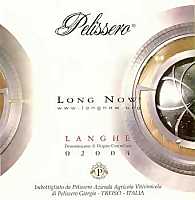
|
|
Langhe Rosso Long Now 2004 |
|
| Pelissero (Piedmont, Italy) | |
| Grapes: Barbera, Nebbiolo | |
| Price: € 20.00 | Score: |
| This wine shows a deep ruby red color and nuances of ruby red, impenetrable to light. The nose reveals intense, clean, pleasing, refined and elegant aromas which start with hints of cherry, violet and plum followed by aromas of blueberry, blackberry, vanilla, tobacco, licorice, cocoa, mace and menthol. The mouth has good correspondence to the nose, a tannic attack and pleasing crispness, however balanced by alcohol, full body, intense flavors. The finish is persistent with flavors of cherry, plum and blackberry. A well made wine. Long Now ages for 18 months in barrique followed by 5 months of aging in bottle. | |
| Food Match: Game, Roasted meat, Braised and stewed meat, Hard cheese | |
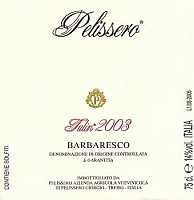
|
|
Barbaresco Tulin 2003 |
|
| Pelissero (Piedmont, Italy) | |
| Grapes: Nebbiolo | |
| Price: € 25.30 | Score: |
| This Barbaresco shows a brilliant ruby red color and nuances of brick red, moderate transparency. The nose denotes intense, clean, pleasing, refined and elegant aromas which start with hints of cherry and plum followed by aromas of violet, raspberry, strawberry, rose, tobacco, vanilla, licorice, pink pepper, cinnamon, chocolate and menthol. The mouth has good correspondence to the nose, a tannic attack and pleasing crispness, however balanced by alcohol, full body, intense flavors. The finish is persistent with flavors of cherry, plum and raspberry. A well made wine. Barbaresco Tulin ages for 18 months in cask followed by 9 months of aging in bottle. | |
| Food Match: Game, Roasted meat, Braised and stewed meat, Hard cheese | |
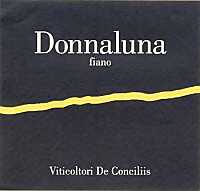
|
|
Donnaluna Fiano 2005 |
|
| De Conciliis (Campania, Italy) | |
| Grapes: Fiano | |
| Price: € 9.50 | Score: |
| This Fiano shows an intense greenish yellow color and nuances of greenish yellow, very transparent. The nose denotes intense, clean, pleasing and refined aromas that start with hints of apple, pear and plum followed by aromas of hawthorn, broom, hazelnut and peach. The mouth has good correspondence to the nose, a crisp attack and however balanced by alcohol, good body, intense flavors. The finish is persistent with flavors of apple, pear and plum. Donnaluna Fiano ages for 4 months in steel tanks and a small part in barrique. | |
| Food Match: Fried fish, Pasta and risotto with crustaceans and fish, Broiled crustaceans | |
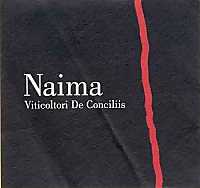
|
|
Naima 2003 |
|
| De Conciliis (Campania, Italy) | |
| Grapes: Aglianico | |
| Price: € 30.00 | Score: |
| Naima shows an intense ruby red color and nuances of garnet red, little transparency. The nose reveals intense, clean, pleasing, refined and elegant aromas which start with hints of black cherry, blackberry and plum followed by aromas of violet, blueberry, licorice, cocoa, mace, graphite, pink pepper, vanilla and menthol. The mouth has good correspondence to the nose, a tannic attack and however balanced by alcohol, good body, intense flavors, agreeable. The finish is persistent with flavors of plum, blackberry and black cherry. A well made wine. Naima ages for 12 months in barrique, 6 months in steel tanks and 4 months in bottle. | |
| Food Match: Roasted meat, Braised and stewed meat with mushrooms, Hard cheese | |
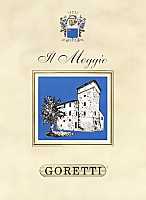
|
|
Il Moggio 2004 |
|
| Goretti (Umbria, Italy) | |
| Grapes: Grechetto | |
| Price: € 10.00 | Score: |
| Il Moggio shows a brilliant golden yellow color and nuances of straw yellow, very transparent. The nose denotes intense, clean, pleasing and refined aromas which start with hints of apple, pear and hazelnut followed by aromas of citrus fruits, hawthorn, pineapple, broom, plum and vanilla. The mouth has good correspondence to the nose, a crisp attack and however balanced by alcohol, good body, intense flavors, agreeable. The finish is persistent with flavors of apple. plum and hazelnut. Il Moggio ages in barrique followed by 4-6 months of aging in bottle. | |
| Food Match: Roasted white meat, Roasted fish, Stuffed pasta | |
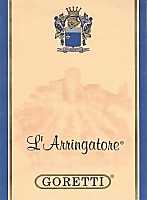
|
|
Colli Perugini Rosso L'Arringatore 2003 |
|
| Goretti (Umbria, Italy) | |
| Grapes: Sangiovese, Merlot, Ciliegiolo | |
| Price: € 14.00 | Score: |
| This wine shows an intense ruby red color and nuances of ruby red, little transparency. The nose reveals intense, clean, pleasing and refined aromas which start with hints of black cherry and plum followed by aromas of blueberry, blackberry, violet, vanilla, toasted, cocoa, cinnamon, tobacco and eucalyptus. The mouth has good correspondence to the nose, a tannic attack and however balanced by alcohol, good body, intense flavors. The finish is persistent with flavors of black cherry, plum and blackberry. L'Arringatore ages for 12 months in cask followed by 12 months of aging in bottle. | |
| Food Match: Roasted meat, Broiled meat and barbecue, Braised and stewed meat, Hard cheese | |
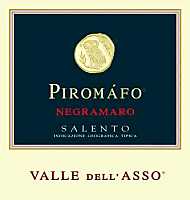
|
|
Piromafo 2001 |
|
| Valle dell'Asso (Apulia, Italy) | |
| Grapes: Negroamaro | |
| Price: € 17.00 | Score: |
| Piromafo shows a brilliant ruby red color and nuances of brick red, moderate transparency. The nose denotes intense, clean, pleasing and refined aromas which start with hints of black cherry, plum and blackberry followed by aromas of violet, tobacco, vanilla, undergrowth, licorice, pink pepper, carob and menthol. The mouth has good correspondence to the nose, a tannic attack and however balanced by alcohol, good body, intense flavors. The finish is persistent with flavors of black cherry, plum and blackberry. Piromafo ages for 12 months in cask followed by 6 months of aging in bottle. | |
| Food Match: Roasted meat, Braised and stewed meat with mushrooms, Hard cheese | |
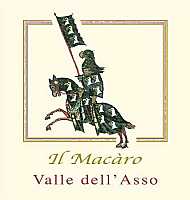
|
|
Il Macaro |
|
| Valle dell'Asso (Apulia, Italy) | |
| Grapes: Aleatico, Malvasia Nera | |
| Price: € 14.00 - 50cl | Score: |
| Il Macaro shows an intense garnet red color and nuances of brick red, moderate transparency. The nose denotes intense, clean, pleasing and refined aromas which start with hints of raisin, plum jam and fig jam followed by aromas of black cherry jam, caramel, date, vanilla, dried violet, tobacco and licorice. The mouth has good correspondence to the nose, a slightly tannic attack and pleasing sweetness, however balanced by alcohol, good body, intense flavors, agreeable. The finish is persistent with flavors of plum jam and black cherry jam. Il Macaro ages for 6 years in cask followed by 6 months of aging in bottle. | |
| Food Match: Fruit tarts, Piquant cheese | |
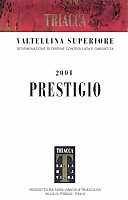
|
|
Valtellina Superiore Prestigio 2001 |
|
| Triacca (Lombardy, Italy) | |
| Grapes: Nebbiolo | |
| Price: € 27.00 | Score: |
| This Valtellina Superiore shows an intense ruby red color and nuances of brick red, moderate transparency. The nose denotes intense, clean, pleasing, refined and elegant aromas which start with hints of plum, cherry and violet followed by aromas of raspberry, rose, vanilla, tobacco, licorice, cinnamon, coffee, chocolate, leather and menthol. The mouth has good correspondence to the nose, a tannic attack and pleasing crispness, however balanced by alcohol, full body, intense flavors. The finish is persistent with flavors of cherry and plum. A well made wine. Valtellina Superiore Prestigio is produced with late harvested grapes, ages for 15 months in barrique followed by 8 months of aging in bottle. | |
| Food Match: Roasted meat, Game, Braised and stewed meat, Hard cheese | |
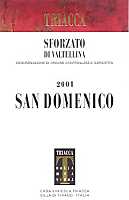
|
|
Sforzato di Valtellina San Domenico 2001 |
|
| Triacca (Lombardy, Italy) | |
| Grapes: Nebbiolo | |
| Price: € 26.00 | Score: |
| This wine shows a brilliant ruby red color and nuances of brick red, moderate transparency. The nose reveals intense, clean, pleasing, refined and elegant aromas which start with hints of cherry, raspberry and violet followed by aromas of plum, rose, strawberry, vanilla, tobacco, licorice, cocoa, cinnamon, leather and menthol. The mouth has excellent correspondence to the nose, a tannic attack and pleasing crispness, however well balanced by alcohol, full body, intense flavors, pleasing roundness. The finish is very persistent with flavors of cherry, plum and raspberry. A well made wine. Sforzato di Valtellina San Domenico is produced with grapes dried for 3 months and ages for 18 months in cask. | |
| Food Match: Game, Roasted meat, Braised and stewed meat, Hard cheese | |
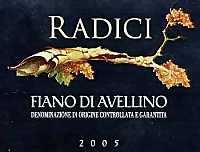
|
|
Fiano di Avellino Radici 2005 |
|
| Mastroberardino (Campania, Italy) | |
| Grapes: Fiano | |
| Price: € 12.00 | Score: |
| This wine shows a pale straw yellow color and nuances of greenish yellow, very transparent. The nose denotes intense, clean, pleasing and refined aromas which start with hints of plum, apple and pear followed by aromas of pineapple, citrus fruits, hazelnut, hawthorn and broom. The mouth has good correspondence to the nose, a crisp attack and however balanced by alcohol, good body, intense flavors. The finish is persistent with flavors of apple, plum and hazelnut. Fiano di Avellino Radici ages in part in steel tanks and in part in barrique. | |
| Food Match: Pasta and risotto with crustaceans, Broiled crustaceans | |
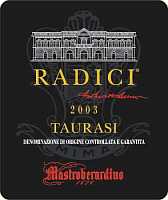
|
|
Taurasi Radici 2003 |
|
| Mastroberardino (Campania, Italy) | |
| Grapes: Aglianico | |
| Price: € 20.00 | Score: |
| Taurasi Radici shows an intense ruby red color and nuances of garnet red, little transparency. The nose reveals intense, clean, pleasing, refined and elegant aromas which start with hints of black cherry, plum and violet followed by aromas of blackberry, blueberry, tobacco, licorice, vanilla, mace, carob, cinnamon and menthol. The mouth has good correspondence to the nose, a tannic attack and however well balanced by alcohol, full body, intense flavors, agreeable. The finish is persistent with flavors of black cherry, plum and blackberry. A well made wine. Taurasi Radici ages for 24 months in cask and barrique followed by at least 12 months of aging in bottle. | |
| Food Match: Game, Roasted meat, Braised and stewed meat, Hard cheese | |
PrunottoWith more than one century of history, Prunotto is one of the most representative wineries for the production of wines in Piedmont's Langhe, from Barolo to Barbaresco, from Dolcetto to Barbera |
|
The territory of Langhe in Piedmont indisputable represents a great land of grapes and wines. In fact, it is enough to pronounce its name in order to recall the powerful Nebbiolo - and therefore Barolo and Barbaresco - as well as Barbera and Dolcetto. Despite of the fame of being a land of great red and robust wines, in the Langhe are also found interesting white wines produced with the autochthonous Arneis and Favorita grapes. However, red wines are the ones to catch the attention of wine lovers. It is enough to think about the many differences which can be expressed by Nebbiolo cultivated and vinified in Langhe - its land - absolutely personal expressions of a territory. Barbaresco and Barolo, for example, are both produced with Nebbiolo, nevertheless they are two completely different wines despite the fact the two territories are only about 20 kilometers apart. Differences which are also very evident inside the same areas: every cru, as it is commonly known, makes a wine different from any other else. The merit for this remarkable result are the tenacity and obstinacy of local producers and the way of interpreting the wine in this land. Among the protagonists in the Langhe, with no doubt, there is Prunotto winery.
The story of this winery begins in 1923, when Alfredo Prunotto - successful wine maker of the most prestigious wineries of those times - acquires the cooperative winery “Ai Vini delle Langhe”, founded at Alba in 1904. Among the founders of this cooperative winery, there was also Alfredo Prunotto, at those times very young but with very clear ideas. In 1922, when the reconstitution of the cooperative winery was about to expire, many partners, despite the year was excellent, decided to not provide their grapes anymore, therefore causing serious problems to the cooperative winery which was about to be closed. Alfredo Prunotto acquired the cooperative winery “Ai Vini delle Langhe” in 1923 and changed its name with his own. Thanks to the passion of Alfredo and his wife, Prunotto winery soon became one of the most affirmed wine businesses of Langhe, exporting its wines all over the world. After a long period of activity and of commitment to enology and wine, in 1956 Alfredo Prunotto retired from his activity. Prunotto winery becomes then property of the friend and wine maker Beppe Colla who, thanks to the help of Carlo Filiberti first and then of his brother Tino Colla, ensured continuity with the same passion and commitment. Prunotto winery did not have its own vineyards, it selected and vinified the best grapes coming from the vineyards of the Langhe, Alba and Monferrato, property of viticulturists with whom existed - and continue to exist - decennial relationships of cooperation based on the same productive vision and philosophy. In 1972, Prunotto winery expands its business and moves to San Cassiano, in the outskirts of Alba, where it is still found the headquarter of the winery. In 1989, Tuscan firm Antinori acquires the Prunotto winery, and begins to take care of the distribution of the wines. In 1990, Antinori acquires 7 hectares of vineyards in the famous cru Bussia, one of the most renowned areas in the Barolo production area. In 1995 they acquire 27 hectares of vineyards in the area of Agliano, where it is found the renowned Costamiole vineyard, famous for Barbera and with the clear aim of starting the production of wines with this grape.
In 1995, when brothers Colla decided to retire from the winery, Antinori takes full control over the production while keeping the excellent quality level started by Alfredo Prunotto and for which he dedicated his activity. It will be Albiera Antinori, the first-born of Marquis Piero Antinori, to delineate the personality of Prunotto winery, by dedicating particular attention and commitment. The expansion of the estate continues in 1997 with the acquisition of two new vineyards, one of 5 hectares in the Barbaresco area - “Bric Turot” - and other 5 hectares in the Treiso area which will be destined to the cultivation of Muscat Blanc. With these new acquisitions, Prunotto winery defines the management and the strict control of every production phase, from vineyard to bottling. Today, Prunotto winery represents one of the most important wine businesses in the Langhe, with a production based on the most important grapes and viticultural areas, from Barolo to Barbaresco, from Moscato d'Asti to Barbera. The yearly production of Prunotto winery is about 800,000 bottles, mostly reds and, in lesser part, Muscat Blanc and Arneis, as well as grappa obtained by the pomace of Muscat Blanc, Barolo Bussia and Ansolà. The production of Prunotto winery is based on quality criteria which begin with the selection of grapes, a scrupulous vinification and the continuous experimentation of new techniques, including the continuous system of pumpover and the vinification in cask barrels. The phases of aging in wood play a very important role in the production of Prunotto's wines. The winery is in fact equipped with new 100 hectoliters casks of French oak, 5 hectoliters tonneaux and 225 liters barriques, in order to have the most appropriate volumes and aging techniques according to each grape variety. Thanks to the availability of many types of casks, at Prunotto winery there is no predefined procedure for the aging of wines. Aging times and types of casks to be used are decided every year according to each variety of wines and of grapes, as well as the quality of every vintage. Also the phases of aging in bottle are scrupulously controlled. At Prunotto the wine is allowed to age in the bottle for the longest time possible, in order to release it on the market when can be ensured the best aging and quality conditions for every single type of wine. Today Prunotto winery owns vineyards in the best areas, the production facility was expanded in 2000 and equipped with the most modern technologies in order to ensure the best quality for wines. The quality of Prunotto's wines is the result of a long experience and a vision about the way of making wine which was developed in about one hundred years of history. The quality which can be found in Prunotto's wines after having poured them in a glass, is always the witness of a scrupulous wine making process, from vineyard to bottle, which since many years continues to charm wine lovers all over the world.
|
||||||||||||||||||||
|
Score legend Prices are to be considered as indicative. Prices may vary according to the country or the shop where wines are bought |
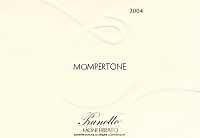
|
|
Monferrato Rosso Mompertone 2004 |
|
| Prunotto (Piedmont, Italy) | |
| Grapes: Barbera (60%), Syrah (40%) | |
| Price: € 10.80 | Score: |
| This wine shows an intense ruby red color and nuances of ruby red, little transparency. The nose denotes intense, clean, pleasing and refined aromas which start with hints of cherry, violet and plum followed by aromas of raspberry, strawberry, vanilla and black pepper. The mouth has good correspondence to the nose, a tannic attack and however balanced by alcohol, good body, intense flavors. The finish is persistent with flavors of cherry and plum. Monferrato Rosso Mompertone ages for 10 months in cask followed by 6 months of aging in bottle. | |
| Food Match: Broiled meat and barbecue, Roasted meat, Stewed meat | |
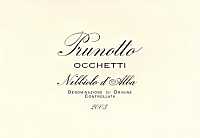
|
|
Nebbiolo d'Alba Occhetti 2003 |
|
| Prunotto (Piedmont, Italy) | |
| Grapes: Nebbiolo | |
| Price: € 13.20 | Score: |
| This Nebbiolo d'Alba shows a brilliant ruby red color and nuances of garnet red, moderate transparency. The nose reveals intense, clean, pleasing and refined aromas which start with hints of cherry, raspberry and violet followed by aromas of strawberry, plum, rose, vanilla, licorice, cinnamon and chocolate. The mouth has good correspondence to the nose, a tannic attack and appreciable crispness, however balanced by alcohol, full body, intense flavors. The finish is persistent with flavors of cherry, plum and raspberry. Nebbiolo d'Alba Occhetti ages for 12 months in cask followed by 4 months of aging in bottle. | |
| Food Match: Roasted meat, Braised and stewed meat, Hard cheese | |
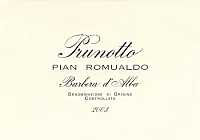
|
|
Barbera d'Alba Pian Romualdo 2003 |
|
| Prunotto (Piedmont, Italy) | |
| Grapes: Barbera | |
| Price: € 14.50 | Score: |
| This Barbera shows an intense ruby red color and nuances of ruby red, little transparency. The nose denotes intense, clean, pleasing and refined aromas which start with hints of cherry, violet and plum followed by aromas of blueberry, strawberry, raspberry, vanilla, chocolate and menthol. The mouth has good correspondence to the nose, a tannic attack and pleasing crispness, however balanced by alcohol, good body, intense flavors. The finish is persistent with flavors of cherry and plum. Barbera d'Alba Pian Romualdo ages for 12 months in cask followed by 10 months of aging in bottle. | |
| Food Match: Broiled meat and barbecue, Roasted meat, Stewed meat with mushrooms | |
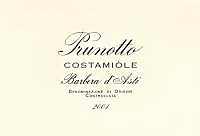
|
|
Barbera d'Asti Costamiole 2001 |
|
| Prunotto (Piedmont, Italy) | |
| Grapes: Barbera | |
| Price: € 25.70 | Score: |
| The wine shows an intense ruby red color and nuances of garnet red, little transparency. The nose reveals intense, clean, pleasing, refined and elegant aromas that start with hints of cherry, plum and blueberry followed by aromas of violet, blackberry, black currant, vanilla, tobacco, licorice, cocoa, mace and menthol. The mouth has good correspondence to the nose, a tannic attack and however balanced by alcohol, full body, intense flavors. The finish is persistent with flavors of plum and cherry. A well made wine. Barbera d'Asti Costamiole ages for 12 months in barrique followed by 12 months of aging in bottle. | |
| Food Match: Game, Roasted meat, Braised and stewed meat, Hard cheese | |
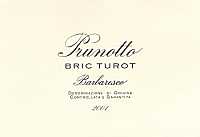
|
|
Barbaresco Bric Turot 2001 |
|
| Prunotto (Piedmont, Italy) | |
| Grapes: Nebbiolo | |
| Price: € 34.30 | Score: |
| Barbaresco Bric Turot shows an intense ruby red color and nuances of brick red, moderate transparency. The nose reveals intense, clean, pleasing, refined and elegant aromas which start with hints of cherry, plum and violet followed by aromas of raspberry, strawberry, blueberry, vanilla, cinnamon, licorice, tobacco, chocolate, mace, pink pepper and menthol. The mouth has good correspondence to the nose, a tannic attack and pleasing crispness, however balanced by alcohol, full body, intense flavors, agreeable. The finish is persistent with flavors of plum and cherry. A well made wine. Barbaresco Bric Turot ages for 12 months in cask followed by 10 months of aging in bottle. | |
| Food Match: Game, Roasted meat, Braised and stewed meat, Hard cheese | |
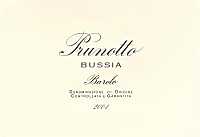
|
|
Barolo Bussia 2001 |
|
| Prunotto (Piedmont, Italy) | |
| Grapes: Nebbiolo | |
| Price: € 38.00 | Score: |
| Barolo Bussia shows a brilliant ruby red color and nuances of garnet red, moderate transparency. The nose reveals intense, clean, pleasing, refined and elegant aromas which start with hints of cherry, plum and violet followed by aromas of vanilla, strawberry, rose, licorice, tobacco, chocolate, coffee, cinnamon, pink pepper and menthol. The mouth has excellent correspondence to the nose, a tannic attack and pleasing crispness, however well balanced by alcohol, full body, intense flavors, agreeable. The finish is very persistent with long flavors of cherry and plum. A well made wine. Barolo Bussia ages for 24 months in cask followed by 12 months of aging in bottle. | |
| Food Match: Game, Roasted meat, Braised and stewed meat, Hard cheese | |
| Prunotto - Regione San Cassiano, 4/G - 12051 Alba, Cuneo (Italy) - Tel. +39 0173 280017 Fax: +39 0173 281167 - Winemaker: Gianluca Torrengo - Established: 1904 - Production: 600.000 bottles - E-Mail: prunotto@prunotto.it - WEB: www.prunotto.it |
Cellar Journal |
|
This section is reserved to wine producers who want to publish news and information about their business, to announce new products or just for communicating to customers information and promotions about their products and activity. Send news to be published to our e-mail address.
|
News |
|
In this section are published news and information about events concerning the world of wine and food. Whoever is interested in publishing this kind of information can send us a mail to our address.
|
Making Wine: Sulfur DioxideAmong the most debated and detested chemical components in wine making, sulfur dioxide is the most important element for the stability and keeping of wine |
|
Sulfur dioxide certainly is one of the most debated and detested chemical component used in enology. Despite the use of chemical substances in the production of wine is pretty frequent, when the subject of chemistry in enology is brought up, sulfur dioxide is the most frequently associated element, as if this would the only one to be used in the production of wine. Indeed, sulfur dioxide is just one of the many chemical elements used in enology, certainly the most common and important one. Sulfur dioxide - whose chemical formula is SO2 - is a colorless gas, with the typical pungent and harsh smell, irritating the eyes and the respiratory tract. The inhalation of this gas can cause pulmonary edema and the prolonged inhalation of high doses can also cause death. Despite the quantities used in enology are minimal and far lesser than the level causing such effects, it is always advisable to take proper precautions and to avoid as much as possible the inhalation of this gas during its use in the many phases of wine production.
Sulfur dioxide is used in enology for its important antioxidant, preservative and antiseptic properties, effects which are indispensable for the health, stability and quality of wine. Despite sulfur dioxide is among the most detested chemical components used in enology, up to now was not possible to find alternative components in order to provide effective antiseptic and preservative like sulfur dioxide, as well as more healthy for man. It should be remembered sulfur dioxide is one of the most common preservatives used in the food and beverage industry, therefore its use is not limited to enology and wine only. European Union identifies and codifies additives and chemical substances used in food industry, with numeric codes preceded by the letter “E” and which must be mentioned in the ingredients list. Codes ranging from E220 and E229 are classified as “sulfurs” - such as sulfur dioxide (E220) and potassium metabisulfite (E224) - all of them having preservative, antiseptic and antioxidant properties. These substances are considered as possible cause of allergic reactions in sensitive or intolerant subjects.
|
||||||||
|
Sulfur Dioxide is used in enology - as already said - for its concurrent antioxidant and antiseptic effects. Despite these positive effects on wine, it must always be remembered its use must always be limited, both because of the negative effects on health as well as for organoleptic reasons. The maximum allowed quantity in enology are set by specific laws in force in every country. As for the European Union, the maximum allowed quantities are 160mg/l for red wines and 210mg/l for white and rose wines. There are dispensations allowing member states to increase this value for a maximum of 40mg/l in case of unfavorable vintages. As sulfur dioxide has toxic effects on the human body, the World Health Organization (WHO) has defined the maximum daily intake in 0.7mg/kg of body weight, whereas the lethal intake is defined in 1.5g/kg of body weight. On this regard, it should be remembered sulfur dioxide can cause hemicrania and other disorders in sensitive and intolerant subjects. It should also be remembered a proper oxygenation before consumption - an operation which can be done by simply swirling the glass - frees about 30-40% of the sulfur dioxide contained in a wine. The rational and intelligent use of sulfur dioxide in wine making, it is not only suggested by healthy issues or “ethical” issues about the limited use of chemistry; its excessive use can drastically compromise the quality of wine. Excessive quantities of sulfur dioxide can in fact give the wine unpleasing flavors and aromas or may favor the wine to become cloudy during its keeping. Sulfur dioxide is not naturally present in the grape, however it can be produced by some yeast species which are naturally found in the must - from few milligrams to more than 50mg per liter - therefore it can be considered as a natural byproduct of wine. Also for this reason it is always recommended to do a proper selection of yeasts in order to ensure a better fermentation process while limiting the production of negative elements which could compromise both the organoleptic quality and stability of wine. Thanks to its antioxidant and antiseptic qualities, the use of sulfur dioxide in wine making is today considered indispensable. In wine making, sulfur dioxide is used since the very first phases of the production, from the must to bottling. In using sulfur dioxide, it is useful to know a part of this gas gets combined with some elements found in the must and wine, whereas the remaining part remains free, that is, non combined. It will be the free part to have antioxidant and antiseptic effects: for this reason it is indispensable sulfur dioxide gets combined for the least possible part. Combined sulfur dioxide is however useful, because in case the free part it is lost - during the operation of decanting, for example - a small part of the combined one gets free and replaces it. It should however remembered this phenomena is pretty limited, therefore it is always indispensable to add sulfur dioxide every time the wine comes in contact with the oxygen, as in the case of decanting, filtering and bottling. The quantity of free sulfur dioxide plus the quantity of the combined part gives the total quantity of sulfur dioxide. Sulfur dioxide is mainly used in the following cases:
As the keeping of wine always represents a critical factor and the preservative effects of sulfur dioxide are always ensured by the free part, in a correctly kept wine must always be present some quantity of free sulfur dioxide. The use of sulfur dioxide in enology can be done in many ways. In home wine making it is always recommended to use potassium metabisulfite also because of its simplicity of use. Potassium metabisulfite is in fact sold in form of salts, it can be easily weighed and can be kept for a long time in an airtight container away from light sources. Potassium metabisulfite contains 55% of sulfur dioxide, therefore each gram contains 550mg of SO2. When the correct quantity has been determined, potassium metabisulfite can be directly added to the must or wine, while stirring the mass with a stick of proper length such to allow a safe distance from the container therefore avoiding the inhalation of the gas which develops during the operation.
|
||||
|
The effects of sulfur dioxide can be classified in four categories: antioxidant, stabilizer, solvent and effects on taste. In the must and in the wine are found many substances which get easily oxidized, therefore changing both their appearance and taste. The use of sulfur dioxide prevents the oxidation of these substances and in particular of coloring substances, tannins, aromas, alcohol and iron. The risks of oxidation during the production of wine are pretty high, a process which begins since the very moment the bunch is harvested and moved to the winery. Moreover, every time the wine undergoes any phase of production, the chance of getting in contact with oxygen is always high, a risk which is further increased when the must or wine is rich in enzymes or molds - such as Botrytis Cinerea - or catalyzing metals, such as iron and copper. For these reasons, the use of sulfur dioxide can limit the effects of oxidation, while ensuring a higher quality and keeping of wine. The stabilizing and antiseptic effect of sulfur dioxide is very important and contributes to a better keeping of wine. The stabilizing effect is also used for the must obtained from white grapes, as it delays the start of fermentation, therefore allowing the decanting of solid parts and favoring the must to become limpid. Sulfur dioxide destroys or momentarily stop the development of bacteria responsible for malolactic fermentation (generally avoided in white wines) and those causing grave faults to wine, such as acescence or volatility as well as lactic acidity. Moreover, the selective action done by sulfur dioxide in yeast species naturally found in the must is very important as well. Every type of yeast is characterized by its own activity during fermentation and behaves differently. In order to ensure a better and more homogeneous fermentation, sulfur dioxide is useful in this case as well. Some yeasts and many bacteria are particularly sensitive to the effects of sulfur dioxide which will then do a proper operation of selection. Some kind of yeasts, which are not very active in the fermentation process and which produce secondary and unwanted substances for the quality of wine, are very sensitive to the effects of sulfur dioxide, whereas the others having a beneficial action during the fermentation, and in particular Saccharomyces Cerevisiae, are more resistant. Thanks to sulfur dioxide it is therefore possible to eliminate unwanted yeasts and bacteria, while keeping the yeasts having a positive role in the alcoholic fermentation. Sulfur dioxide has a solvent property and favors the extraction of some substance found in the skins of the grape. During the maceration of skins of red grapes in the must, sulfur dioxide favors the extraction of coloring substances and tannins. For this reason it is always recommended to avoid the adding of sulfur dioxide in white grapes as this would cause the must to have a deep yellow color and too much tannins. In the must produced with white grapes, the adding of sulfur dioxide is always done after the separation of solid parts. Among the other solvent effects, sulfur dioxide favors the extraction of mineral substances and acid. Sulfur dioxide has also a positive effect on wine flavors and aromas. According to an organoleptic point of view, it avoids the oxidation of aromas, in particular fruit aromas typical in young wines, attenuates the tastes of rot and mold. In order to get these positive effects, sulfur dioxide must be added when the alcoholic fermentation is completely done. In case it is added too early, when the wine is still fermenting, that is when the temperature is too high, it can happen the development of unpleasing tastes and aromas, such as sulfur dioxide, mercaptan and rotten eggs. Sulfur dioxide also has a bland clarifying effect, as it favors the coagulation of colloidal substances found in wine and in the must, therefore favoring the spontaneous precipitation of lees. Sulfur dioxide, added in high quantity to the must, is used to obtain the so called “mutage on must”, that is a non fermentable must, because of the interruption of yeasts activity. Despite the effects of sulfur dioxide in wine making are indispensable and important, it is however and always recommended to limit its use and to add the least possible quantity, first of all, in order to reduce the effects on the health of the subjects particularly sensitive to this gas. This precaution is particularly important in the production of wines requiring high quantities of sulfur dioxide, in particular in sweet wines and in wines having a high content of residual sugar, wines to which can be added, also according to law, higher quantities of SO2. In any case, after having added sulfur dioxide, it is indispensable to stir the wine or the must homogeneously, while trying to be as much as possible precise in the preparation of the quantity: always and however the least indispensable. Finally, it should be remembered it is always preferred to add sulfur dioxide the less frequent possible although at higher quantities. The frequent and repeated adding of small quantities causes in fact the increasing of total sulfur dioxide. The antioxidant and stabilizing effects on wine and on the must - it should be remembered - are uniquely done by free sulfur dioxide and not by the combined part.
|
PotatoComing from South America, Potato is today common all over the world and it is considered the most important vegetable of the earth for human nutrition |
|
Potato is a tuber coming from South America, belonging to the family of Solanaceae, its name derives from “batata”, a word used for referring to sweet potato. South American people use this tuber since more than 4000 years, they learned how to select a huge number of varieties, virtually suited for every climate. Known all over the world, potato is today the most important vegetable of the earth for human nutrition. «Indians harvest papas and then dry them under the sun, they use them for making what they call chuno, which can be kept for many days and which is used as a bread and in this land are widely traded in the mines of Potosì. They also eat raw, boiled or roasted papas… There is a considerable trading of chuno (dried potatoes) which is mainly done in the mines of Potosì». This is how Josè de Acosta described in 1589 potatoes in his “Historia moral y natural de las Indias Occidentales” (Moral and natural history of Western Indies).
|
Potatoes are very common in Mexico and South America since more than 4000 years; in Europe were introduced by Spaniards in 1570 and spread in the other countries, in particular Germany and Austria. In the beginning of 1600s it was imported in England, where it soon became the main food for poor people. In 1719 arrived in the United States introduced from Ireland. Potatoes saved whole generations of people during the wars which tormented Europe from 1600 on. The army of Napoleon was used to set on fire crops in order to put the people to be conquered on famine. Peasants were then forced to replace cultivation of wheat with potatoes, as they did not burn, could be kept and hidden underground, under the sand or in cellars, for a long time and safely. Potato was one of the cause for the immigration of Europeans overseas. Famine of the last half of the nineteenth century forced hundreds of thousands of Irish, German, English and Dutch peasants to find better life conditions in America. Potato is currently found everywhere in the world and it probably is the most important vegetable of the earth. The cultivation of potato is done in all the continents from the 70° latitude north to the tropics, adapting itself to very different climates. The main producer of potatoes is China that with its 67 millions of tons covers 21% of worldwide production.
|
||||||||
|
In Italian patata, in French pomme de terre, in German kartoffeln, in Spanish patata. Potato, (Solanum tuberosum), coming from Mexico and South America, is a herbaceous plant with a green trunk, the edible part is made of the extremities of the underground runner, which gives origin to the potato. Leaves are opaque green, rough and slightly hairy in the lower side, flowers are white or violet, grouped in clusters, fruits are pulpy and round berries containing many small and flat seeds. Potato requires a tempered climate and fresh soils, rich in humus, the multiplication is done by tubers, which can be planted whole or in pieces, provided every piece has at least two sprouts. The sectioning of potatoes must be done at least eight days in advance in order to allow the tuber to form cicatrices, therefore eliminating the possibility of infections. The sowing is done during the months of March or April (for early potatoes it is done in December), by planting the tubers at about 5-10 centimeters deep, in order to have 5-6 plants for square meter. In August (for early potatoes in April), when the stems gets dried, it is proceeded with harvesting. Tubers must be kept in rooms shielded from light, with a temperature from 0 to 8° C (32-46° F) in order to avoid germination, a cellar would be the best place. It is good to check the potatoes out from time to time and to remove the sprouts which begin to develop. Potatoes must not be kept together with fruits, in particular with apples who accelerates the germination process. Industrial processing of potatoes avoids germination by using specific chemical products. It should also be avoided the keeping of potatoes in plastic bags, as this would prevent tubers to “breathe”. According to a cultural point of view, by considering the same area, potatoes produce a richer crop than cereals and it is more easy to cultivate and to harvest. For this reason the cultivation of potatoes rapidly spread all over the world. There are many varieties of potatoes, however they can be classified in the following generic categories, all of them usually found in green groceries:
|
||||
|
Potatoes are used both for human and animal nutrition, they are also a precious resource for the cosmetic industry. Yellow pulp potatoes, are suited for being boiled, roasted, fried, cooked in the oven or steamed. White floury pulp potatoes are suited for the preparation of puré, puddings, dumplings and soufflé. Scientific studies done in Greece have defined the perfect “formula” for the preparation of fried potatoes, a study which required, it seems, one year. The result of this study suggest to peel and cut potatoes in sticks one centimeter large and four long, which are then put in the microwave oven at maximum power for two minutes. Then the oil is heated (which must be of vegetal origin) at a temperature of 170° C (338° F). Finally, the potatoes are fried for 12 minutes and 30 seconds. Potatoes are characterized by a high content in starch and a moderate content in proteins. It is important to pay attention to green stains which can be found on the skin, as they signal the presence of solanine, a toxic alkaloid. Solanine is found in the skin and however in the external part and in sprouts. When the presence of these stains is found, or when potatoes are characterized by a bitter taste, it is recommended to eliminate the part by deeply peel them or even - for safety reasons - to discard them. The intake of solanine for more than 400mg is responsible for headaches, vomit, cramps to the stomach and diarrhea. In potatoes the content of solanine is lower than 100mg per kilogram, however it should be considered the cooking of potatoes in water reduces the initial content of about 40-50%. Despite the presence of solanine, it is very improbable to get intoxicated with potatoes: one should eat 4 kilograms of raw potatoes or 8 kilograms of boiled potatoes. Solanine disappears after a prolonged cooking at 170° C (frying or baking). The nutritional properties of potatoes are very interesting, in fact for many people they still make the base food of their nutrition, they are very rich in vitamin C, starches and mineral substances such as phosphor, iron and magnesium. Many believe potatoes are very caloric, however this is not true. One hundred grams of potatoes provide about 80 calories while giving, at the same time, a sense of satiety. Two hundreds grams of potatoes correspond to about 50 grams of pasta or to 75 grams of bread. Because of its properties, potatoes are an easily digestible food, suited for diabetics, anyone being overweight, to the ones suffering kidney insufficiency, gout and hypertension, thanks to its low content in sodium. What makes potatoes caloric and less digestible are condiments, because of the high capacity of absorbing fats used during cooking. As an example, boiled potatoes with a little of salt can replace bread in the diet, however fried potatoes, as they tend to absorb fats and oils during cooking, are absolutely forbidden to anyone being on a ipocaloric diet. One hundred grams of raw potatoes contains: 83% of edible part, 78.5g of water, 2.1g of proteins, 1g of fats, 18.9g of carbohydrates, 15.9g of starch, 0.4g of soluble sugar, 1.6g of fibers, 7mg of sodium, 570mg of potassium, 0.6mg of iron, 10mg of calcium, 54mg of phosphor, 0.10mg of vitamin B1, 0.04mg of vitamin B2, 2.5mg of vitamin PP, 3µg of vitamin A, 15mg of vitamin C. the most simple way to cook potatoes is boiling. There are two school of thought about this subject: some support the idea potatoes must be boiled with the skin, others prefer to peel them. In case it is preferred to boil potatoes without skin, they must be peeled, any bruise should be removed and then soaked in salted water. Then it is brought water to full boil, by considering lesser quantities of water ensure a lower loss of substances and mineral elements from the tubers. As the water boils, potatoes are poured and allowed too cook for 20 minutes. To check whether potatoes are cooked, it is enough to dig the blade of a knife or a fork: when no hard parts are encountered inside the tuber, the potato is cooked. In case it is preferred to boil potatoes with the skin, they should be carefully washed before proceeding with cooking. When purchasing potatoes, particular attention must be paid on the skin, which must be whole, with no stains, sprouts or clefts.
|
AquavitaeReview of Grappa, Distillates and Brandy |
|
|
| Distillates are rated according to DiWineTaste's evaluation method. Please see score legend in the "Wines of the Month" section. |

|
|
Grappa di Malvasia 2001 |
|
| Casa Luparia (Piedmont, Italy) | |
| Raw matter: Pomace of Malvasia di Casorzo | |
| Price: € 18.00 - 50cl | Score: |
| This grappa is colorless, limpid and crystalline. The nose reveals intense, clean, pleasing and refined aromas of grape, strawberry, rose, raspberry, violet, cyclamen and peach with almost imperceptible alcohol pungency. In the mouth has intense flavors, perceptible alcohol pungency which tends to dissolve rapidly, pleasing roundness, balanced sweetness, agreeable. The finish is very persistent with long flavors of strawberry, raspberry and grape. A well made grappa produced with a discontinuous alembic still operating at low pressure. Alcohol 42%. | |

|
|
Grappa Pini 1993 |
|
| Zeni (Trentino, Italy) | |
| Raw matter: Pomace of Teroldego | |
| Price: € 31.00 - 70cl | Score: |
| This grappa shows an intense amber yellow color, limpid and crystalline. The nose reveals intense, clean, pleasing and refined aromas of dried fig, tobacco, licorice, vanilla, prune, hazelnut, honey, blackberry jam, black cherry jam and cocoa with almost imperceptible alcohol pungency. In the mouth has intense flavors, perceptible alcohol pungency which tends to dissolve rapidly, pleasing roundness, balanced sweetness, agreeable. The finish is very persistent with long flavors of hazelnut, prune and honey. A well made grappa distilled with a discontinuous bainmarie alembic still and aged in cask. Alcohol 40%. | |
Wine Parade |
|
|
| The best 15 wines according to DiWineTaste's readers. To express your best three wines send us an E-mail or fill in the form available at our WEB site. |
| Rank | Wine, Producer | |
|---|---|---|
| 1 |
| Wine Obsession 2001, Vignamaggio (Italy) |
| 2 |
| Amarone della Valpolicella Classico 2000, Zenato (Italy) |
| 3 |
| Brunello di Montalcino 1999, Castello Banfi (Italy) |
| 4 |
| Chianti Classico Riserva Novecento 2000, Dievole (Italy) |
| 5 |
| Nero al Tondo 2001, Ruffino (Italy) |
| 6 |
| Notarpanaro 1999, Taurino (Italy) |
| 7 |
| Chianti Classico Riserva Novecento 2000, Dievole (Italy) |
| 8 |
| Colli Orientali del Friuli Rosazzo Bianco Terre Alte 2002, Livio Felluga (Italy) |
| 9 |
| Don Antonio 2003, Morgante (Italy) |
| 10 |
| Trento Talento Brut Riserva Methius 1998, Dorigati (Italy) |
| 11 |
| Amarone della Valpolicella Classico Costasera 2001, Masi (Italy) |
| 12 |
| Sagrantino di Montefalco Collepiano 2003, Arnaldo Caprai (Italy) |
| 13 |
| Soave Classico Monte Alto 2004, Ca' Rugate (Italy) |
| 14 |
| Sforzato di Valtellina Canua 2001, Conti Sertoli Salis (Italy) |
| 15 |
| Sagrantino di Montefalco 2003, Antonelli (Italy) |
| |||||||
Privacy Policy | |||||||


| Copyright © 2002-2024 Antonello Biancalana, DiWineTaste - All rights reserved |
| All rights reserved under international copyright conventions. No part of this publication and of this WEB site may be
reproduced or utilized in any form or by any means, electronic or mechanical, without permission in writing from DiWineTaste. |